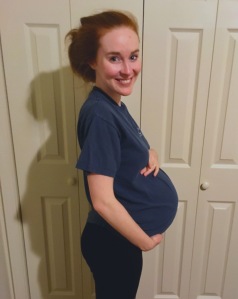If you have ever heard of Red Raspberry Leaf Tea, you’ve probably been told something about its supposedly amazing and seemingly magical powers for easing labor. I found out about it in the first week of my third trimester and decided to give it a try. Here is my experience with it.
First, I researched RRL exhaustively. If I was going to put something this powerful into my body, I wanted to make sure it was safe to do so. My investigation into the matter satisfied my questions and concerns, so I bought a large pack of tea the next day and began drinking three teabags per day. By the time I started drinking RRL, I was in the second week of my third trimester.
I noticed that RRL gave me some Braxton-Hicks contractions, but I didn’t experience any pain or real signs of labor. These Braxton-Hicks felt like my body was “working out” in preparation for labor, and they honestly made me feel more confident in my body’s ability to deliver. RRL also eased some of my pregnancy-related stomach issues.
I greatly increased my RRL intake once I hit 36 weeks, often drinking 5 teabags or more per day. I didn’t see any side effects from making this change, but I definitely wouldn’t recommend that anyone else do this since I’m neither a doctor nor a midwife. One thing I don’t have any qualms about recommending, however, is exercise during pregnancy. I am a dance teacher, and I taught dance throughout my second trimester and some of my third. By the time I took my maternity leave, I tried to take at least one walk per day and never skipped a day of stretching. I also did lots of pelvic-aligning exercises and 30 squats per day at home. I made my body the main priority of each day, and my last trimester was easier because of this.
I began drinking the 24-teabag “Labor Day” recipe that has become famous in the natural birth community the day before and the day of my due date. Nothing happened. I drank it again the next day. Again, nothing. I was at my wit’s end.
I was officially 4 days overdue when my doctor told me that I needed to be induced. I know that there are many mothers out there who do not believe in induction, but I trusted my doctor to make the right decision. I was not happy about the idea of being induced–in fact, I cried about it the rest of the day–but I soon accepted it and even began to be thankful that I had a definite date to look forward to meeting my baby.
The next day, I drank more of my Labor Day tea and prayed that God would give me a quick, easy, and calm labor. As the day wore on, my Braxton-Hicks turned into something different. These were real labor contractions–they had a kick to them that I had not experienced before.
My husband and I arrived at the hospital at 6:00 PM that evening and I was given my first half-dose of Cytotec at 7:30. Labor moved so quickly after that first half-dose, however, that I never took another. My labor lasted about 8 hours from that first half-dose until my daughter was born. Although it was a physical challenge, I never felt that I couldn’t handle each contraction.
The hardest part of my labor was when I hit the “transition” phase. I felt the contractions becoming harder and harder, and I knew that if they continued to escalate I would not be able to handle them. I had no idea how much longer my labor would last (my doctor had told me to expect a 30-hour labor), and I believed in that moment that I would need to get an epidural.
Thankfully, my doula was there to encourage me. She helped out in so many ways and gave me the courage to press on towards my goal of going epidural-free. Transition was the most intense part of my labor, but because of my doula I no longer doubted my ability to cope. This transition period lasted only about 10 minutes for me. After a few pushes, my daughter was in my arms. As intense as labor had been, it could not compare with the beauty of my first moment with her.
 Overall, my recovery was very easy. I drank my RRL for two weeks postpartum and sprang back to my normal self quite fast. I felt energetic and had a great nursing experience to boot. To the right is a picture of me, 6 days postpartum. I honestly feel that RRL helped me just as much postpartum as it did in pregnancy.
Overall, my recovery was very easy. I drank my RRL for two weeks postpartum and sprang back to my normal self quite fast. I felt energetic and had a great nursing experience to boot. To the right is a picture of me, 6 days postpartum. I honestly feel that RRL helped me just as much postpartum as it did in pregnancy.
I hope that this story was helpful to you. Please research red raspberry leaf tea for yourself and try it out if you feel comfortable doing so. I firmly believe that if more mothers drank it, we would witness a boom in positive pregnancy, birth, and postpartum experiences. Best wishes to you in your motherhood journey!
[…] a great organic version. My doctor told me to expect a thirty-hour labor, but it only lasted eight hours. I sincerely believe that it was this tea that made the difference. Of course, do some research […]
LikeLike
[…] your body for labor and has the ability to make birth easier, faster, and less painful. My first labor lasted a mere eight hours, and I credit this tea for making it such a quick and bearable […]
LikeLike
[…] Drink 3 to 5 cups of red raspberry leaf tea. […]
LikeLike